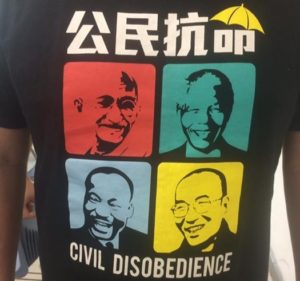Minds of the Movement
An ICNC blog on the people and power of civil resistance
by Maciej BartkowskiAugust 14, 2017
This article is also available in Polish (here).
In my interactions with people from around the world, I’ve been asked a recurring question: how do we build mass mobilization in a society that is demobilized? In other words, how do we transform the dissent of a few into the resistance of many?
The question is often born out of activists' frustration with a perceived public apathy, feelings of resignation and fear among key members of civil society, and a general withdrawal of citizens from public life.
It’s important to understand how movements and campaigns emerge in circumstances where few expect they would. Here is a non-exhaustive list of factors that help to account for how a struggle can grow beyond a handful of committed activists:
1. Cognitive Awakening
Once people realize that they are part of the problem, and their very actions or inaction sustain injustice, they move one step closer to another type of realization: that if they are part of the problem, they can be also part of the solution—provided they choose to organize and change their established pattern of behavior.
2. Seeing that Alternatives are Possible
People compare themselves to others and relate to what others have or enjoy. In learning about how other, more just societies function, people realize that things can be indeed different and the situation can be improved.
3. Exhaustion of Institutional Means
People realize that a normal course of action through existing institutional channels does not work and does not bring expected results. They begin discussing the alternative courses of action that are feasible, given skills and resources available or those that could be acquired.
4. Costs, Risks, Benefits and Values are Considered
There is consensus that nonviolent action is the only available course forward, as it is more likely to draw in huge numbers of people. They feel, often intuitively, that nonviolent actions are safer, more achievable, and are more closely aligned with the values undergirding their demands for justice and democratic rights.
5. A Specific Campaign Goal is Set
People realize that their grievances about the status quo are often too general to mobilize others and need to be represented by a specific issue that is illustrative or symbolic of the existing injustice. This specific issue dramatizes the injustice, elevates visibility of that injustice to others, wins potential supporters, can easily be linked to other problems, and becomes a triggering or catalytic factor for movement takeoff. At the same time, the issue instills in people a sense of power, thus creating a snowball effect for further mobilization.
6. Reaching Out to Others through Apolitical Networks
Activists realize they must reach out to others who are not like them to increase the chances of successful mass mobilization. These connections or relationships might be initially formed around unrelated issues pursued by seemingly apolitical groupings: recreational sports clubs, parents' associations, street markets, hobby groups, owners of small garden plots, neighborhood watch formations, or centers offering primary healthcare or basic welfare services where people from different walks of life meet and interact. Activists may be able to turn these webs of social interactions into more politicized networks that can be activated for a specific political cause.
7. Proactive and Synchronized Actions
People are no longer reactive to government actions and begin initiating events themselves. Actions also become synchronized. Activists continually articulate the vision behind the resistance; identify general goals that resonate with a larger population, thus making them legitimate (even more so than the legitimacy of powerholders’ claims that the situation does not warrant dissent); and delineate the boundaries of actions to be taken—namely that they should remain nonviolent in nature, explaining why it is important to remain nonviolent. Newly joined organizers and activists take the initial vision and turn it into specific campaigns that visualize and dramatize injustice. The dramatizations make the general public aware of the problem and possible solutions that mobilize potential sympathizers and bystanders. The campaigns help pave the way for shifting loyalties in favor of the emerging movement.
8. The Durability of the System is Questioned
People realize that the status quo is no longer sustainable. The hypocrisies of the rulers are exposed and the system is shown to be fragile and ineffective, based on a lie that is increasingly apparent to the majority of the population. The people withdraw their consent to be governed, and political structures are weakened so much that the ruling elite is forced to concede to some or to all of the movement’s demands.
In short, the mere awareness of injustice—even a blatant one—does not foster a movement. This is not an exhaustive list; any single factor is necessary but not sufficient in producing successful civil resistance rising. The latter requires a vision and its articulation, and a viable strategy that takes into account the psychological aspects of people’s awakening.
SaveSave

Maciej Bartkowski
Dr. Maciej Bartkowski is a Senior Advisor to ICNC. He works on academic programs to support teaching, research and study on civil resistance. He is a series editor of the ICNC Monographs and ICNC Special Reports, and book editor of Recovering Nonviolent History. You can follow him @macbartkow
